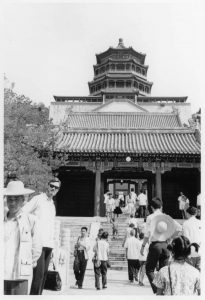President Richard Nixon’s famous visit to China in February of 1972 symbolically formalized the normalization of relations between the United States and China. The two countries had been adversaries for decades, but warming American-Chinese relations allowed for the “opening up” of the planet’s most populous nation to the Western world.
Computer design specialists from the two countries were early beneficiaries of this improved relationship. Just a few months after President Nixon’s visit, a group of six American computer experts toured China in the summer of 1972. During this unprecedented learning exchange expedition, the American computer experts visited computing facilities, participated in lectures on advances in computer technology, and met with Chinese computer experts. Two of the six members of the American delegation had Washington University connections. The group of six consisted of:
- Thomas Cheatham (Harvard University)
- Wesley Clark (Washington University)
- Anatol Holt (Massachusetts Computer Associates)
- Severo Ornstein (Bolt, Beranek and Newman — formerly at Washington University)
- Alan Perlis (Yale University)
- Herbert Simon (Carnegie-Mellon University)
Becker Library’s Wesley A. Clark Papers collection contains correspondence, memorandums, notes and over 100 photographs taken by Wes Clark on the three-week trip to China in 1972.

At the time, Westerners knew very little about Chinese computing abilities because China had isolated itself from the outside world for several decades. The delegation found that the Chinese had much more advanced computer systems than they had anticipated. At the Shanghai Computer Institute, the group observed computers used for weather forecasting, structural analysis, optical lens design, dam calculations, bridge design, scheduling, and computational mathematics.
The most advanced computer the Americans saw was the Model 111 at the Peking Institute of Computer Technology, an integrated circuit machine which included a cathode ray tube display monitor. After meeting with their Chinese counterparts and touring multiple universities and computer-building factories in Shanghai and Beijing, the delegation concluded that the Chinese were well-informed in all areas of computer design and technology.

The delegation would be one of many such good-will groups to visit China in the following years aimed at reestablishing friendship between the two countries. This group of six American computer scientists opened the channels for technical dialogue between the computer specialists of both countries. Following the success of this visit, the National Academy of Science’s Committee on Scholarly Communication with the People’s Republic of China made plans to host a similar delegation of Chinese computer experts the following year. In 1973, a Chinese delegation of computer specialists spent five weeks visiting various sites across the US, including a tour of the Computer Systems Laboratory at Washington University.
More information about the 1973 Chinese delegation’s visit to Washington University and the groundbreaking 1972 American group’s visit to China can be found in Becker Library’s Wesley A. Clark Papers.






